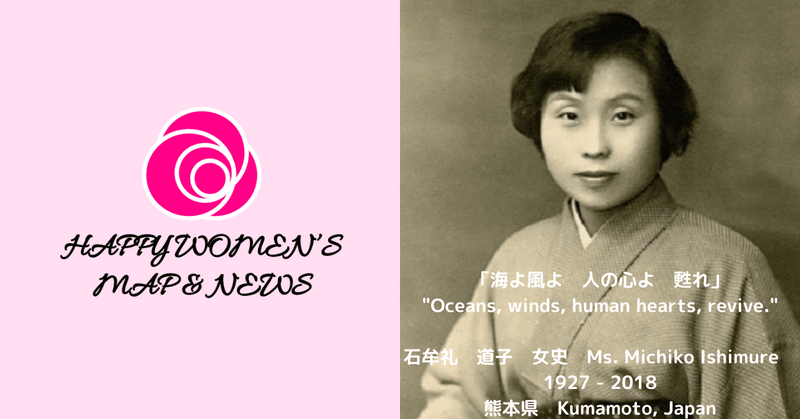
Happy Women's Map 熊本県 水俣病闘争の主導者 石牟礼 道子 女史

「海よ風よ 人の心よ 甦れ」
"Oceans, winds, human hearts, revive."
石牟礼 道子 女史
Ms. Michiko Ishimure
1927 - 2018
熊本県天草市 生誕
Born in Amakusa-city, Kumamoto-ken
石牟礼 道子女子は、水俣病闘争を主導した日本における環境運動の先駆者です。水俣病ならびに近代社会の苦しみを訴える『苦海浄土 わが水俣病』を刊行。ならびに水俣病患者の支援組織「水俣病を告発する会」を結成。さらに水俣病を通して近代社会の断層を記録するべく「不知火海百年の会」ならびに「不知火海総合学術調査団」を結成。
Michiko Isummure is a pioneer in the environmental activist in Japan who led the fight against Minamata disease. She published "My Minamata Disease: Paradise in the Sea of Sorrow", which served as a testimony to the suffering caused by Minamata disease and modern society. She also established the support organization for Minamata disease patients, "Minamata Disease Disclosure Society." Furthermore, to document the rifts in modern society through the lens of Minamata disease, she founded the "Firefly Sea Hundred-Year Society" and the "Firefly Sea Comprehensive Academic Research Team."
*******
≪じぶんの体があまりに小さくて、ばばしゃまぜんぶの気持ちが、冷たい雪の外側にはみ出すのが申しわけないきがしました≫
道子は、道路・港湾工事を手がける石工棟梁の家に生まれます。祖父は住み込みまた通いの職人数十人ならびに妾また隠し子を抱え、祖母は発狂、父・亀太郎は経理を担って一家の放漫経営を支え、母・ハルノは祖母の世話ならびに職人集団の賄い・酒宴の支度を引き受け、道子は神経の病んだ祖母と心通わせます。
≪にじの国 -とこしえに未完のうた、-これをあなたにお返し致します≫
やがて家業が破綻、一家で水俣川河口に引っ越します。水俣町立第一小学校を卒業後は、会社勤めをしようと水俣実務学校(現 熊本県立水俣高等学校)に入学。戦時下の教員不足により、本人の抵抗も空しく、16歳で代用教員となります。軍事教育に嫌気が差した道子は登校拒否教師となりますが、生徒はじめ校長先生に支えられて終戦を迎えます。アメリカ主導の皇室排除ならびに民主主義教育が始まると、道子は亜ヒ酸で自殺未遂を起こします。さらに20歳の時に家族のためにいやいや嫁ぐも4か月で自殺未遂を起こします。
≪おもかげや 泣きなが原の 夕茜≫
夫・弘は実直で評判の教師で組合活動にも熱心ながら、道子の精神的な話相手にはなろうとしません。1年後に一人息子・道夫が生まれると、道子は水汲み・家事・炊事・洗濯・畑仕事・裁縫の休息日である雨の日に、無料の美術教室・図書館に通います。毎日新聞熊本歌壇に投稿を始めてからは、歌人・蒲池正紀主催の短歌会に参加。そこで歌友・志賀狂太と交流を深め、一緒に死のうとするも先立たれます。
≪毒死列島 身悶えしつつ 野辺の花≫
32歳の道子は、初期結核で入院する道夫と訪ねた市立病院で水俣病患者と出会い衝撃を受けます。熊本大学主宰の水俣病診療会場に出かけて患者また付き添いに紛れ込んで会話に加わって聞き書きを始め、大学の解剖台の上に運ばれて解剖されるまでじっと見続けます。発言の場を求めて、筑豊炭鉱を拠点とする文化運動「サークル村」に参加、機関紙『サークル村』にて「水俣湾漁民のルポルタージュ」を発表します。その後、渡辺京二編集『熊本風土記』にて「海と空のあいだに」を連載発表、42歳の時に『苦海浄土わが水俣病』として講談社から刊行。渡辺京二とともに「水俣病を告発する会」を結成、機関紙『告発』刊行。患者らと一緒に、厚生省水俣病補償処理委員会会場を占拠してビラを配って直訴、大阪のチッソ株主総会に乗り込んで加害責任を直接追及、東京のチッソ本社前に1年8か月座り込んで社長との直接交渉を実現します。訴訟終結後、さらに道子は「不知火海百年の会」ならびに「不知火海総合学術調査団」を結成、水俣病を通して見え始めた近代社会の断層をあらゆる角度から地域住民はじめ専門家ですくいあげ普遍化する取り組みを開始。さらに、美智子皇后に手紙をおくり、2013年天皇皇后両陛下の水俣胎児性患者との対面を後押しします。
"I felt that my own body was too small, and I felt sorry that all of my feelings for my grandmother overflowed beyond the cold snow."
Micniko was born into a family of stonemason foremen who worked on road and harbor construction. Her grandfather employed numerous live-in and visiting craftsmen, along with concubines and illegitimate children. Her grandmother suffered from mental illness. Her father, Kametaro, managed the family's business affairs, while her mother, Haruno, took care of her grandmother and catered to the needs of the group of craftsmen. Michiko developed a close bond with her mentally unstable grandmother.
"The Rainbow Nation - An Eternal Unfinished Song, I offer this to you."
As the family business eventually went bankrupt, they relocated to the mouth of the Minamata River. After graduating from Minamata Municipal First Elementary School, Michiko enrolled in Minamata Practical School (now Kumamoto Prefectural Minamata High School) with the intention of pursuing corporate employment. Due to a shortage of teachers during the wartime, her own resistance notwithstanding, she became a substitute teacher at the age of 16. Disenchanted with military education, she later became a teacher who had refused to attend school, but she survived until the end of the war with support from her students and the school principal. With the advent of American-led reforms that included the removal of the imperial system and the introduction of democratic education, Michiko attempted suicide with potassium cyanide. She made another suicide attempt four months after reluctantly getting married at the age of 20.
"Faint traces, tears fall in the evening glow on the endless plain"
Her husband, Hiroshi, was an honest and reputable teacher actively involved in union activities but was unable to be a confidant for Michiko's emotional struggles. A year later, their son Michio was born. On rainy days, which served as her respite from drawing water, housework, cooking, laundry, gardening, and sewing, Michiko attended free art classes and visited the library. After she began submitting her work to the Kumamoto poetry column in the Mainichi Shimbun, she participated in a tanka gathering hosted by poet Masanori Gamai and established a deep connection with fellow poet Kyoji Shiga. They attempted to end their lives together, but he passed away before her.
"A chain of poisonous islands, writhing amidst the wildflowers of the field"
At the age of 32, while visiting the city hospital with her son Michio, who was hospitalized for early-stage tuberculosis, Michiko encountered Minamata disease patients and was deeply affected. She visited the Minamata disease medical examination site organized by Kumamoto University, mingled with patients and their caregivers, and began recording their conversations, remaining steadfastly present as autopsies were performed on examination tables at the university. Seeking a platform for her voice, she joined the "Circle Village," a cultural movement centered in the Chikuho coal mining area, and published a report on "Minamata Bay Fishermen" in its publication, "Circle Village." Later, she serialized "Between the Sea and the Sky" in "Kumamoto Folklore" edited by Keiji Watanabe and published "My Minamata Disease: The Bitter Sea, My Pure Land" at the age of 42 by Kodansha. Together with Keiji Watanabe, she formed the "Minamata Disease Disclosure Society" and published the magazine "Disclosure." Michiko, along with the patients, occupied the Ministry of Health, Labor and Welfare's Minamata Disease Compensation Processing Committee venue, distributed flyers, and made direct appeals. They also confronted the Chisso Corporation at the shareholder meeting in Osaka, directly holding them accountable for their actions. Furthermore, they sat in front of Chisso's Tokyo headquarters for a year and eight months, eventually achieving direct negotiations with the company president. After the legal resolution, Michiko further established the "Firefly Sea Hundred-Year Society" and the "Firefly Sea Comprehensive Academic Research Team." Through her Minamata disease advocacy, she began to shed light on the rifts in modern society from various angles, involving local residents and experts, working towards universalizing their efforts. Additionally, she sent a letter to Empress Michiko, advocating for a meeting between the Emperor and Empress and Minamata's congenital Minamata disease patients in 2013.
-水俣病資料館 Minamata Disease Municipal Museum
-くまもと文学・歴史館 Kumamoto Museum of Literature and History

Share Your Love and Happy Women's Story!
あなたを元気にする女性の逸話をお寄せください!
Share your story of a woman that inspires you!
この記事が気に入ったらサポートをしてみませんか?
